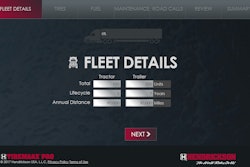This blog was provided exclusively to CCJ by Joe Puff, vice president of truck technology and maintenance, NationaLease.
Technicians often think of tires as mundane, basic, simple necessities. I view them as a specialty item, much like diesel engines, transmissions, brakes, air conditioning, refrigeration, after treatment systems, and the like. If you are not treating tires the same as you do other key components of the truck, your fleet could be losing tens of thousands of dollars. I’d like to suggest a few ways tires can help you save you money.
 Joe Puff, vice president of truck technology and maintenance, NationaLease
Joe Puff, vice president of truck technology and maintenance, NationaLeaseWhat’s the best way to improve your tire usage: Invest in a quality trained tire leader. You may choose one of your technicians who is well versed and trained about tires, or you could hire a tire manager. What you need is someone who knows tread designs, air pressures for the applications, casing management, proper dismounting/mounting procedures, and repair conditions. It is critical that this person be someone who has a thorough understanding of tire root cause analysis.
When a shop doesn’t have a responsible specialist managing tires, the door is open for many missed opportunities, especially in the area of tire selection and root cause failure analysis. A responsible tire manager will establish and maintain casing repair and retread rules, casing inventory tracking, and train other technicians on proper mounting procedures, repairs, and irregular wear identification.
I have found that a fleet manager or tire manager can learn a lot from a few daily random tire inspections and air pressure checks. Stopping poor performance or sloppy work at the source is critical in proactively reducing cost and breakdowns. Once technicians realize their work may be re-inspected, it generally drives the right behavior.
I also encourage managers to do an occasional scrap tire review. A scrap tire review should provide answers to the following questions:
- Are damaged tires identified and drivers counselled?
- Are corrective actions taken when misalignment is identified?
- Is the retreader accountable for their failed repairs or retreads?
- Does the retreader reimburse the casing value for failed repairs by the retreader?
- Are technicians counseled for chipped beads?
- If a 0/32 tire is found, is the responsible party accountable and counseled?
If the root cause of a failure isn’t identified and corrective actions taken, it will be very difficult to drive the cost out of tires.
Given the technological advancements in tires, it’s critical to have an on-going tire testing program to validate data. I’ve witnessed a fleet scrub off tires at 500 miles per /32 for years. However, after a couple simple quick tests, the miles per /32 doubled and shortly thereafter, tripled. The problem was no one person had responsibility for managing the tire program; it was just accepted as “that’s the way it’s always been and a necessary evil.” Once someone took on responsibility for the tires, the fleet made decisions based on facts and data.
While this example was from an extreme-duty application, the fleet was able to cut its tire costs in half or more. It should not take years to identify simple tire opportunities, but unless someone is accountable for testing and managing, it is difficult to quantify the systemic problems and drive out cost.
A good tire manager needs to be trained on the following:
- Failure analysis
- Proper tire and tread selection
- Casing management and inventory
- Proper mounting and repair procedures
The tire manager must understand the importance of a tire management program to the fleet’s overall profitability.
But the person in charge of the fleet’s tire management program should not have to go it alone. Most tire dealers and tire manufacturer are extremely knowledgeable and helpful. They can be a great resource for tire training, fleet evaluations, root cause analysis, and tire selection. It may require a call for help, but don’t be bashful. Leverage your resources and challenge them to help you resolve any ongoing tire issues.
If you want to test your tire knowledge, I suggest you review the Technology & Maintenance Council’s Radial Tire Conditions Analysis Guide. Review the failed tire photographs whole covering the information provided on the cause of the failure to see if you can correctly identify the cause of a particular failure. TMC’s guide is a great review and training tool.
In the previous article in this series, The Basics Of Tire Inflation, I talked about the significant benefits of increased tire life by having the right air pressure. Truck-by-truck specific pressures for the specific application can take some effort and management, but can also have huge payoffs.
The same holds true for selecting the tire and tread design best suited for a specific application as I outlined in the first article in this series, Selecting The Right Tire.
When you put someone in charge of managing your tires, they should be aware of everything having to do with tires from selecting the right tire, to ensuring proper inflation pressures, to casing management and failure analysis. Taken all together, this attention to your tires should result in some significant savings for your fleet
It would seem that tires are not so mundane, basic or simple after all.












